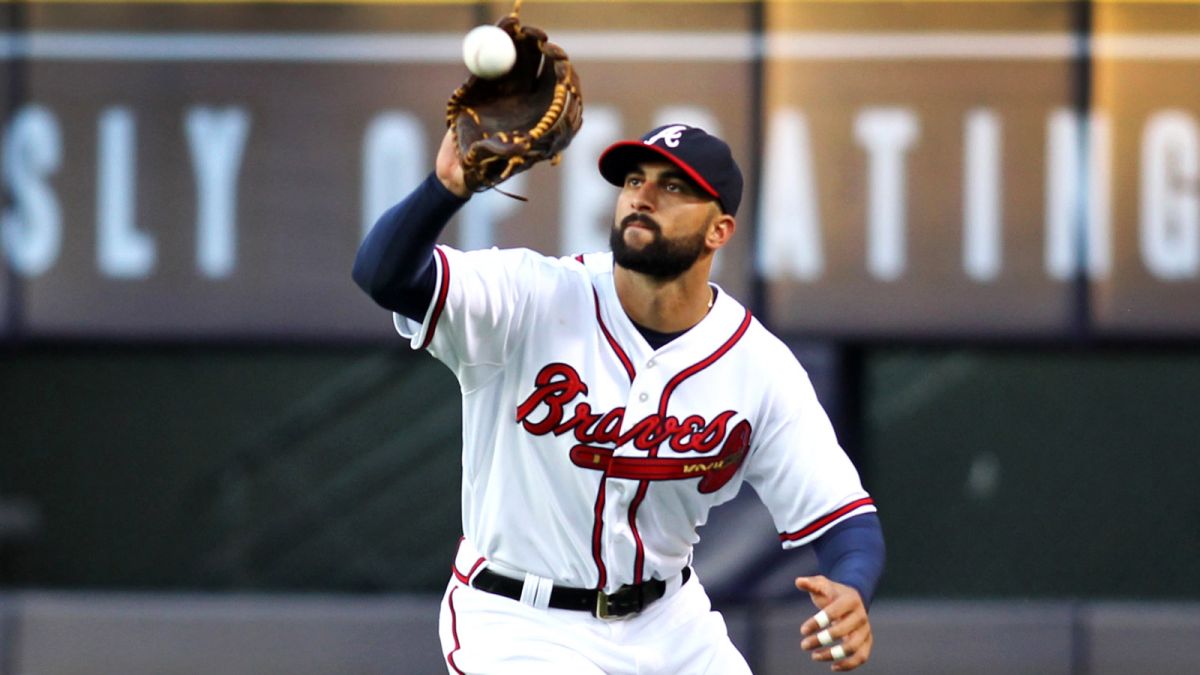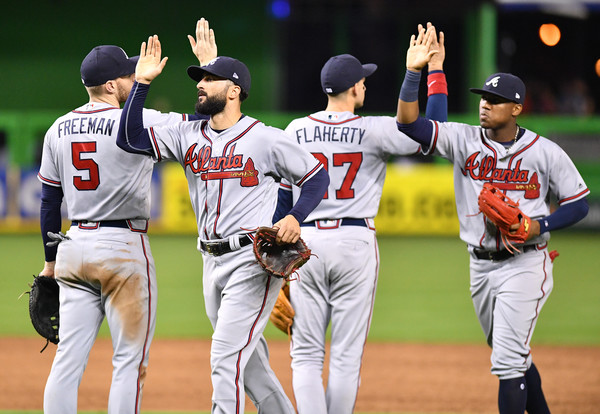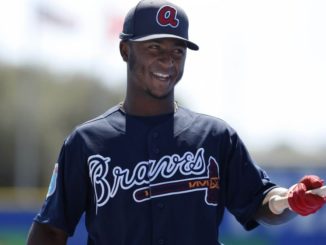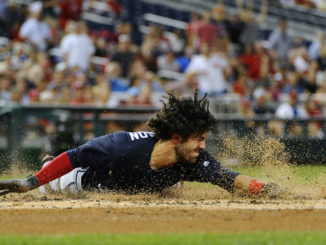
Every season, there are players who seem to break out early as the season starts. Sometimes, it’s a player off the radar, like Colorado Rockies shortstop Trevor Story a few years ago, or Ryan Flaherty for the Atlanta Braves this year. Other times, we see established aging players seem to rejuvenate their careers, like this year’s version of Braves’ right fielder Nick Markakis. And every year, bloggers and analysts tell fans to beware that evil specter known as ‘regression.’ “He can’t sustain this!” “He’s never done it before!” We’ve all heard how our current flavor of the month will turn back into a pumpkin at midnight. That refrain about regression usually applies to players who are benefiting from ‘luck’, or who have not made any substantive changes in approach and are still seeing better than expected results. But what happens if a player – like Markakis, for example – sees a sort of late career resurgence with what seems to be changes to his approach? Are those results then sustainable for most of a season?
To quickly recap, Nick Markakis is having what might be a career best year at age 34, in the 13th season of what could become a Hall of Fame career. As of this writing, he has a .926 OPS (.333/.408/.518), with seven home runs and an ISO of .185. The ISO (a measure of how often a player hits for extra bases) ties his career high, which he posted in back to back seasons in 2007 and 2008. Markakis only hit eight home runs in 2017, and he didn’t hit his seventh home run until August 15th. He’s on pace for 27 home runs, which would surpass his previous career high of 23, set in 2007. He is also on pace for 216 hits, which would be another career high. His wRC+ of 153 would be his career high by a large margin (138 wRC+ in 2008). Put bluntly, Markakis is kicking ass and taking names.
When Markakis first signed with the Braves, I wrote at the time that I thought he was a good complementary piece, and that he didn’t strike me as a centerpiece for a rebuilding team. I still maintain that he seemed more of a side dish than an entrée, but, overall, he has not been bad in Atlanta. So why is Nick Markakis now having a career year at 34, and why do I think he can sustain it and avoid significant regression?
Nick Markakis Has a New Plate Approach
It’s clear Markakis has subtly changed his approach at the plate this year. He seems more patient in waiting for a pitch he can drive. His 11.5% BB Rate is the second highest of his career, and he’s striking out at the lowest rate of his career. His 8.9% K Rate this year ranks as the fourth lowest among all qualified batters, behind former Atlanta Brave Andrelton Simmons, Michael Brantley, and the criminally underrated Jose Ramirez (those are the only four qualified players in MLB who strike out in fewer than 10% of their trips to the plate). Markakis has always sported very good strikeout ratios, but he’s been even better thus far in 2018. And while strikeouts are generally not much worse than other types of outs (they are worse, and significantly so in certain situations, but overall, there is not a large difference between outs), keeping the line moving by forcing the action is generally a good thing.
In addition, according to the Plate Discipline information from Fangraphs, Markakis is swinging at fewer pitches outside of the strike zone (21.6%) than in any year of his career, except 2008. He is also swinging at more pitches inside the strike zone (67.3%) than he ever has. This is resulting in more walks and less weak contact (and seems to support my theory that lineup protection comes more from the guys getting on base in front of a batter, and not behind him). We saw a similar change in approach from Freddie Freeman after Matt Kemp arrived. While Freeman did not see any measurable increase in strikes, it allowed him to select better pitches to swing at, instead of feeling as if he needed to do all the run production himself with one swing.

Nick Markakis Has a New Batted Ball Profile
We’re giving the Fangraphs database a workout here. According to their Batted Ball data, Markakis is hitting line drives more often than he ever has in career (28.9%), and much more often than his career rate of 20.9%. He ranks 12th in MLB among qualified batters in LD Rate. We like this, because Line Drives go for hits much more often than other type of batted ball.
| BA | OBP | SLG | ISO | wRC+ | BABIP | |
|---|---|---|---|---|---|---|
| Ground Ball | .238 | .238 | .259 | .021 | 31 | .238 |
| Fly Ball | .225 | .220 | .679 | .454 | 130 | .114 |
| Line Drive | .684 | .679 | .915 | .230 | 346 | .676 |
In addition to hitting more line drives, Markakis is also hitting fewer ground balls. While ground balls go for hits more often than fly balls, they also go for fewer bases than fly balls, on average. Also, fewer ground balls generally means fewer double plays. With his fading speed (such that it was), Markakis is doing himself a big favor by adding some lift and not hitting the ball on the ground as often. This helps more hits fall in, and it increases the odds of those hits going for extra bases.
According to both Fangraphs and MLB’s own StatCast data, Markakis is hitting more balls classified as ‘Hard Hit’ than he has in any other year, except 2008. For his career, 29.4% of the balls Markakis has put in play have been classified as Hard Hit. This year, that figure is up to 33.6%. Hitting more balls hard is good.
Is It Sustainable?
Markakis enters tonight’s play with a .338 Batting Average On Balls In Play (BABIP). The MLB BABIP for 2018 is .295, and it generally hovers near .300. Whenever a player has a BABIP that is significantly higher than either the league average or their career average, we should dig a little to find out the ‘why’. Often, we just see a guy getting some fortunate bounces without any measurable or observable changes in approach or mechanics. This is generally when blowhard bloggers like myself start mentioning ‘regression’. With no changes in approach, those lucky flares and squibbers are going to stop missing some gloves and start hitting others. Nature likes an equilibrium, and eventually, those good or bad hops tend to normalize, inching back more in line with that ~.300-ish equilibrium BABIP.
Certainly some players can have an increased BABIP. Players with great speed tend to outperform the norm, for example. In the case of Markakis, though, his career BABIP is .317, and with the Braves it has been .321. While he’s sporting a figure a little higher than that so far this year, it’s not an extreme deviation from his career norm. And, the higher BABIP is easily explained by his batted ball profile. In fact, the only aspect of this season that I think might be unsustainable for Markakis is his HR per Fly Ball rate. It currently sits at 14.6%, which would mark the best of his career. His career rate is 8.2%, so I would expect the current mark to come down slightly. But even then, while some home runs will be lost, some doubles and singles will be gained.
Markakis has certainly not been this productive in his recent past. It wouldn’t be unreasonable to think that he is a candidate to fall back down to Earth. However, that would only apply if there were no reasons for the change (which were mentioned previously) or if he had never done this before. But, in fact, Markakis has done this before. This season is shaping up eerily similar to his 2008 campaign that saw him post a 6.0 fWAR.
| AVG | OBP | SLG | ISO | wRC+ | |
|---|---|---|---|---|---|
| 2008 | .306 | .406 | .491 | .185 | 138 |
| 2018 | .333 | .408 | .518 | .185 | 153 |
| K% | BB% | HR/FB | GB/FB | BABIP | |
| 2008 | 16.2% | 14.2% | 12.6% | 1.40 | .350 |
| 2018 | 8.9% | 11.5% | 14.6% | 1.25 | .338 |
The Takeaway
Markakis is having a career year, and signs point to it being something he can continue doing. He has increased how often he walks and hits line drives, and he has reduced his strikeouts and ground balls. He’s swinging at less junk, and he’s swinging at significantly more pitches inside the strike. His overall contact rate, whiff rate, and rate of pitches seen in the zone are all at his career averages. Nothing is terribly out of whack when looking at his peripherals. All of that seems to suggest that come July, the Braves might want to consider keeping Nick Markakis around for the rest of what is turning into a very fun and exciting season.




Leave a Reply